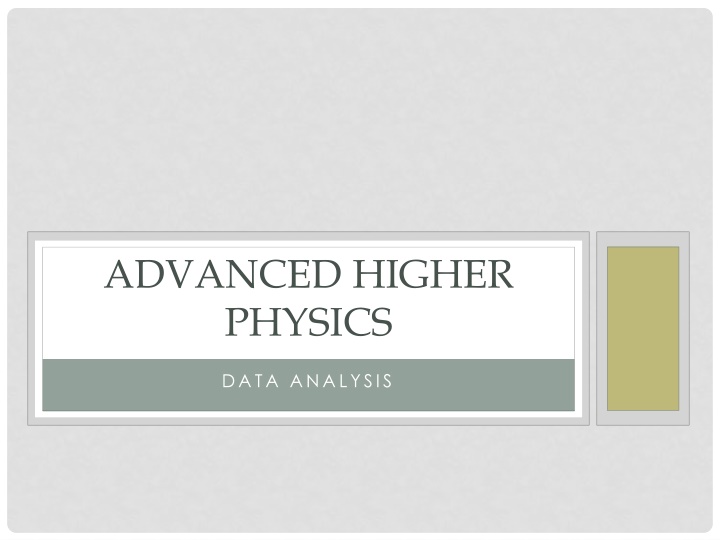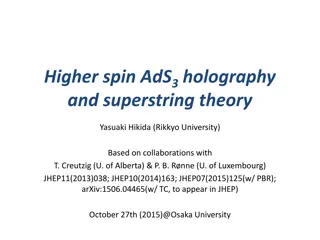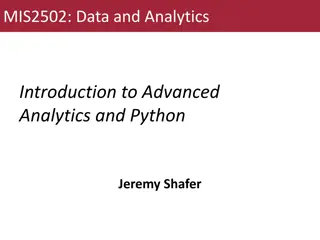
Physics Data Analysis Techniques and Uncertainty Handling
Learn about handling uncertainties in physics data analysis, including percentage uncertainty, combining uncertainties through addition, subtraction, multiplication, division, and powers, along with guidelines for graphing data with uncertainties.
Download Presentation

Please find below an Image/Link to download the presentation.
The content on the website is provided AS IS for your information and personal use only. It may not be sold, licensed, or shared on other websites without obtaining consent from the author. If you encounter any issues during the download, it is possible that the publisher has removed the file from their server.
You are allowed to download the files provided on this website for personal or commercial use, subject to the condition that they are used lawfully. All files are the property of their respective owners.
The content on the website is provided AS IS for your information and personal use only. It may not be sold, licensed, or shared on other websites without obtaining consent from the author.
E N D
Presentation Transcript
ADVANCED HIGHER PHYSICS DATA ANALYSIS
PERCENTAGE UNCERTAINTY Single measurements may be quoted as measurement absolute uncertainty, for example 53.20 0.05 cm. When measured quantities are combined (e.g. when the quantities are multiplied, divided or raised to a power) to obtain the final result of an experiment it is often more useful to quote measurement percentage uncertainty, where: Always compare percentage uncertainties never absolute uncertainties
PERCENTAGE UNCERTAINTY A percentage uncertainty in an individual measured quantity can be regarded as insignificant if it is less than one third of any other percentage uncertainty. Absolute uncertainty should always be rounded to one significant figure.
COMBINING UNCERTAINTIES Addition and subtraction When two quantities P with absolute uncertainty P, and Q with absolute uncertainty Q, are added or subtracted to give a further quantity S, the absolute uncertainty in S, is given by:
COMBINING UNCERTAINTIES Multiplication and division When two quantities P with absolute uncertainty P, and Q with absolute uncertainty Q, are multiplied or divided to give a further quantity S, the percentage uncertainty in S is given by:
COMBINING UNCERTAINTIES Powers When a quantity P is raised to a power n to give a further quantity Q, then When measured quantities are combined it is usual to ignore any percentage uncertainty that is not significant; a percentage uncertainty in an individual measured quantity can be regarded as insignificant if it is less than one third of any other percentage uncertainty.
GRAPHING When graphing quantities that include uncertainties, note the following points. Each individual point on the graph should include error bars, on one or both of the quantities being plotted, as appropriate. The error bars on each point could indicate either the absolute uncertainty or the percentage uncertainty in the quantities being plotted, as appropriate. The error bars are used to draw the best straight line or the best fit curve, as appropriate.
THE CENTROID METHOD This can be used to estimate the uncertainty in the gradient and the uncertainty in the y-intercept of a straight-line graph. Plot the points and error bars. Calculate the centroid of the points. The x co- ordinate of the centroid is the mean of the values plotted on the x-axis and the y co-ordinate of the centroid is the mean of the values plotted on the y- axis. Draw the best fitting straight line through the centroid.
THE CENTROID METHOD Construct a parallelogram by drawing lines, which are parallel to this line, and which pass through the points furthest above and furthest below this line. Calculate the gradients, m1and m2, of the diagonals of the parallelogram. (These two diagonals represent the greatest and least values that the gradient could have.) Calculate the uncertainty in the gradient, m using:
THE CENTROID METHOD where n is the number of points (not including the centroid) plotted on the graph. Read off the intercepts, c1and ,c2on the y-axis, of the diagonals of the parallelogram. Calculate the uncertainty in the intercept, c using: Again, n is the number of points (not including the centroid) plotted on the graph.
ACCURATE, PRECISE OR BOTH? For the following three pictures, would you say they are accurate, precise, both or neither?
ANSWER (a)Is netiher (b)Accurate and precise (c)Precise but inaccurate





















